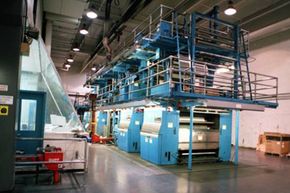Newspaper Production
The production division does the heavy lifting of newspaper work. Within this division's departments are specialists who run and maintain the presses, typesetters, image scanners and photographic engraving machines. Some workers are assigned to the day shift, others to the night shift.
Beginning around 1970, newspaper production divisions began a historic shift away from the labor-intensive technology of Linotype typesetters and other "hot type" machines used in relief printing. This was the same technique used by Johannes Gutenberg in the 14th century: pressing a page of paper directly onto a block of type. The invention of "cold type" based on photographic processes sped production and cut the high overhead costs of relief printing. Also, cold type worked better with new offset printing presses coming into use.
Advertisement
Most daily newspapers use some form of offset printing. This process etches the image of a newspaper page onto thin aluminum plates. (Pages with color photos or type require extra plates.) These plates, now bearing a positive image developed from a full-page photographic negative, then go to other specialists for mounting on the press. The process is called offset because the metal plates do not touch the paper going through the press. Instead, the plates transfer their inked image to a rubber roller, which in turn prints the page.
Although newspaper presses are big and noisy, they are remarkably gentle on newsprint, the paper in newspaper. The presses have to be gentle -- expensive newsprint streaming off huge rolls must wind through a press without tearing. These complex machines, which can cost tens of millions of dollars and reach seven stories tall, are called "web presses" because they use streaming paper instead of individual sheets [source: Knoxville News Sentinel].
In addition to putting ink on paper, the press also assembles the pages of a newspaper in correct sequence. All this occurs so quickly that a modern offset-press can spew 70,000 copies an hour onto conveyor belts that speed the copies to the waiting distribution division [source: Knoxville News Sentinel].
